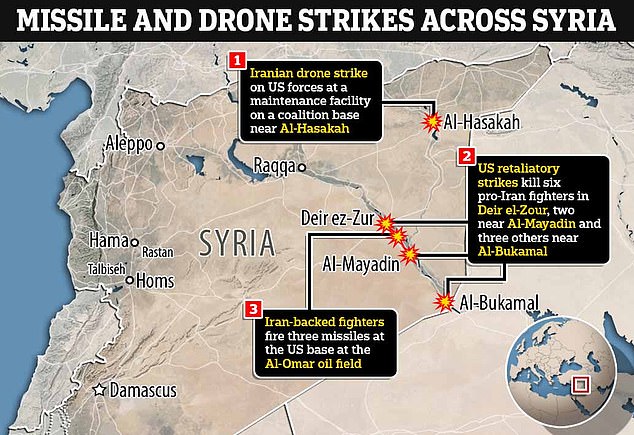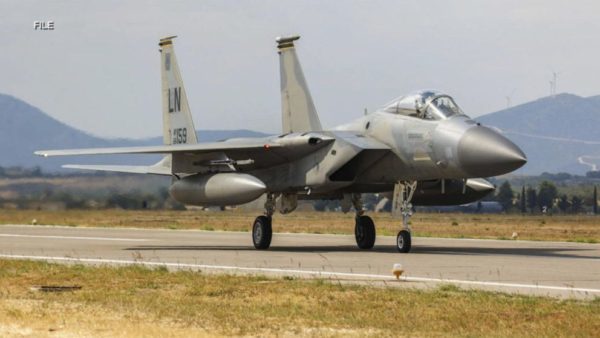A new missile strike targeted a U.S. base in northeast Syria Friday, a day after a U.S. contractor was killed and five U.S. service members and another U.S. contractor wounded when a suspected Iranian drone hit a coalition base in the same region, according to U.S. officials. U.S. officials confirmed the new attack targeting an American base southeast of the Syrian province of Der el-Zour on Friday, saying there were “lots of rockets” fired, but no known U.S. casualties.
Reports surfaced earlier that the Friday missile salvo had targeted a U.S. base near the Al-Omar oil field in northeast Syria. The Reuters news agency and local media, including a pro-Iran outlet based in Lebanon, first reported the strike. Photos and reports on social media suggested at least one missile had missed the intended target, hitting homes in the region instead.
The attack came just hours after U.S. Defense Secretary Lloyd Austin said in a statement that U.S. Central Command forces had retaliated for Thursday’s deadly drone attack with “precision airstrikes” against facilities in eastern Syria used by groups affiliated with Iran’s Revolutionary Guard. The Defense Department said the intelligence community had determined the unmanned aerial vehicle used in the Thursday attack was of Iranian origin.

Two of the wounded U.S. service members were treated on site, while three others and the injured contractor were transported to medical facilities in Iraq, the Pentagon said. President Biden expressed his condolences to the families of the Americans during a visit to Canada on Friday and said the U.S. would not hesitate to retaliate against Iranian aggression.
“Last night, U.S. military forces carried out a series of military strikes in Syria, targeting those responsible for attacking our personnel. My heart and deepest condolences go out to the family of the American we lost, and wish a speedy recovery for those who were wounded,” the president said. “The U.S. does not seek conflict with Iran, but be prepared for us to act forcefully to protect our people.”
The Syrian Observatory for Human Rights, an opposition war monitor, said the American strikes killed six Iranian-backed fighters at an arms depot in Deir el-Zour on Thursday. The Observatory, which relies on a network of local contacts in Syria, said the U.S. also bombed an outpost near the town of Mayadeen, killing another two fighters.
A separate American strike hit a military post near the town of Boukamal, along the border with Iraq, on Thursday the Observatory said. CBS News has not confirmed the report.
“The airstrikes were conducted in response to today’s attack as well as a series of recent attacks against Coalition forces in Syria” by groups affiliated with Iran’s Revolutionary Guard, Austin said, adding that he authorized the retaliatory strikes at the direction of Mr. Biden.
“As President Biden has made clear, we will take all necessary measures to defend our people and will always respond at a time and place of our choosing,” Austin said. “No group will strike our troops with impunity.”
“The United States took proportionate and deliberate action intended to limit the risk of escalation and minimize casualties,” Austin said.
U.S. Army Gen. Michael “Erik” Kurilla, the head of the American military’s Central Command, warned that American forces could carry out additional strikes if needed. “We are postured for scalable options in the face of any additional Iranian attacks,” Kurilla said in a statement.
In testimony to the House Armed Services Committee on Thursday, Kurilla said Iran’s drone fleet had become “the largest and most capable unmanned aerial vehicle force in the region,” according to Reuters.
Overnight, videos on social media purported to show explosions in Syria’s Deir el-Zour, a strategic province that borders Iraq and contains oil fields. Iran-backed militia groups and Syrian forces control the area, which also has seen suspected airstrikes by Israel in recent months allegedly targeting Iranian supply routes.
Iran’s paramilitary Revolutionary Guard, which answers only to Supreme Leader Ayatollah Ali Khamenei, has been suspected of carrying out attacks with bomb-carrying drones across the wider Middle East. In recent months, Russia has begun using Iranian drones in its attacks on sites across Ukraine as part of its war on Kyiv. Iran has denied being responsible for these attacks, though Western nations and experts have tied components in the drones back to Tehran.
The attack and U.S. response threaten to upend recent efforts in the region to deescalate tensions, as Saudi Arabia and Iran have been working toward reopening embassies in each other’s countries. The kingdom also acknowledged efforts to reopen its embassy in Syria, whose embattled President Bashar Assad has been backed by Iran in his country’s long war.
Syria’s state-run SANA news agency didn’t immediately acknowledge any strikes. Syria’s mission to the United Nations didn’t immediately respond to a request for comment. There was no immediate reaction from Iran to the strikes, which come during the holy Muslim fasting month of Ramadan. Iran’s mission to the United Nations also didn’t immediately respond to a request for comment.
The U.S. under President Biden has carried out multiple attacks in Syria, usually targeting Iran-linked groups. In February and June of 2021, as well as August 2022, he authorized attacks there.
U.S. forces entered Syria in 2015, backing allied forces in their fight against the ISIS terror group. The U.S. still maintains the base near Hasakah in northeast Syria, however, where Thursday’s drone strike happened. There are roughly 900 U.S. troops, and even more contractors, in Syria.
Syria’s war began with the 2011 Arab Spring protests that roiled the wider Middle East and toppled governments in Egypt, Libya, Tunisia and Yemen. It later morphed into a regional proxy conflict that’s seen Russia and Iran back Assad. The United Nations estimates over 300,000 civilians have been killed in the war. Those figures don’t include soldiers and insurgents killed in the conflict; their numbers are believed to be in the tens of thousands.
CBS


Leave a Reply
You must be logged in to post a comment.